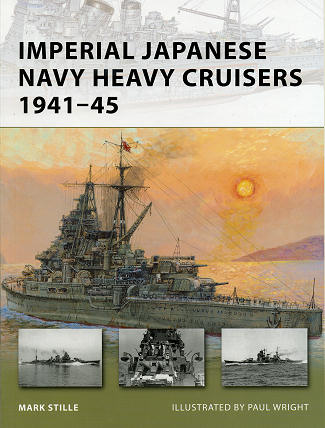Osprey's Imperial Japanese
Navy Heavy Cruisers 1941-45
|
Author |
MarkStille illustrated by Paul Wright |
|
Publisher/Distributor |
Osprey Publishing |
|
Price |
$17.95 MSRP |
|
Reviewer: |
Scott Van Aken
|
|
Notes: |
48 pages, 7¼ x 9¼ inches, softcover
ISBN: 978-1-84908-148-1 |
 Like
Great Britain, Japan relied on the sea to provide for its people. Everything
from food to most strategic materials had to be transported over the oceans.
Once Japan opened up to Western ideas, they fully embraced the need to have a
strong navy and looked to whomever could help them to produce the sort of
weapons they needed for their military.
As an island nation, the Japanese felt that a strong Navy was important
and after WWI, it saw its greatest competition from the United States.
Like
Great Britain, Japan relied on the sea to provide for its people. Everything
from food to most strategic materials had to be transported over the oceans.
Once Japan opened up to Western ideas, they fully embraced the need to have a
strong navy and looked to whomever could help them to produce the sort of
weapons they needed for their military.
As an island nation, the Japanese felt that a strong Navy was important
and after WWI, it saw its greatest competition from the United States.
Knowing that they could not match their
strongest adversary (the United States), in terms of sheer numbers, the Japanese
set out to be do what they could in terms of producing ships of superior
quality. Thus, their ships tended to put offensive capabilities ahead of
defense, especially when it came to armor. Japanese cruisers were considered to
be very lightly protected when compared to the ships of other nations. Instead,
that weight saved was put into additional guns and systems.
One system that the Japanese favored was
the use of the torpedo. Their cruisers all had some sort of torpedo capabilities
and their crews trained with them all the time. From fixed tubes amidships, they
finally went to multiple tube mounts on swivel bases. However, like many weapons
systems, more was expected from this that was actually achieved. And there was
always the danger of an incoming shell hitting the torpedoes and causing great
damage. To their dismay, this did happen in several instances during the Pacific
War. Yet these ships were very successful, despite being almost totally
destroyed during the length of the war.
This book in the New Vanguard series
looks at the five major classes of Japanese heavy cruisers: the Furutaka and
Aoba, Myoko, Aoba, Mogami, and Tone class of ships. Each class is provided a basic history of the ships
as well as the design and modifications made to them as time progressed. There
are a superb number of period photos of each type as well as cutaways and the
excellent artwork of Paul Wright to help us visualize what these ships were like
in action.
It is fortunate for the US that the
Japanese missed several opportunities to put their heavy cruisers to good use as
commerce raiders. Though there were minor attempts at this in the Indian Ocean,
the Japanese would rather take on other warships and the opportunity to really
cause havoc against cargo ships and transports was missed. It is probably no
surprise that most of these ships were lost due to air power than any other
cause, as against dedicated dive bombers and torpedo planes, they were no match.
An excellent book on a most interesting
subject and one that I am positive you will find to be of interest. One that
will be pulled from the shelves time after time and one I can highly recommend
to you.
February 2011
For more on the complete line of Osprey books,
visit www.ospreypublishing.com. In the US, it is
Osprey Direct at 44-02 23rd St, Suite 219, Long Island City, NY 11101., where you can
get a catalogue of available books.
If you would like your product reviewed fairly and quickly, please
contact
me or see other details in the Note to
Contributors.
 Like
Great Britain, Japan relied on the sea to provide for its people. Everything
from food to most strategic materials had to be transported over the oceans.
Once Japan opened up to Western ideas, they fully embraced the need to have a
strong navy and looked to whomever could help them to produce the sort of
weapons they needed for their military.
As an island nation, the Japanese felt that a strong Navy was important
and after WWI, it saw its greatest competition from the United States.
Like
Great Britain, Japan relied on the sea to provide for its people. Everything
from food to most strategic materials had to be transported over the oceans.
Once Japan opened up to Western ideas, they fully embraced the need to have a
strong navy and looked to whomever could help them to produce the sort of
weapons they needed for their military.
As an island nation, the Japanese felt that a strong Navy was important
and after WWI, it saw its greatest competition from the United States.